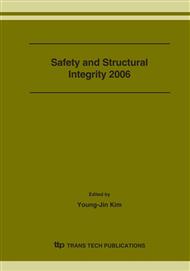p.157
p.163
p.169
p.175
p.181
p.187
p.193
p.199
p.207
Wear Characteristics of Tube-Support Components for a Nuclear Steam Generator under Fretting Conditions
Abstract:
Tubes in nuclear steam generators are held up by supports because the tubes are long and slender. Fluid flows of high-pressure and high-temperature flows in the tubes cause oscillating motions between tubes and supports. This is called as FIV (flow induced vibration) which cause fretting wear in contact part of tube-support. The reduction of tube thickness due to fretting wear of tube-support can threaten the safety of nuclear power plant. Therefore, a research on the fretting wear characteristics of tube-support is required. This work is focused on investigations of fretting wear characteristics and wear mechanisms of tube-support. Results show that the wear rate of tube is proportional to that of support and that with increasing the water temperature the wear volume of tube-support decreases because the oxidation rate decreases due to reduction of the oxygen concentration in contact surfaces. Also, the wear mechanisms of tube-support are abrasive and oxidational wear.
Info:
Periodical:
Pages:
181-186
Citation:
Online since:
February 2007
Authors:
Keywords:
Price:
Сopyright:
© 2007 Trans Tech Publications Ltd. All Rights Reserved
Share:
Citation:


